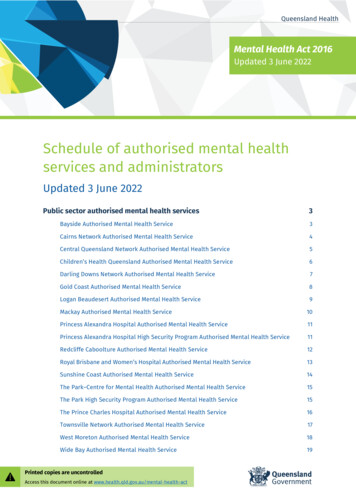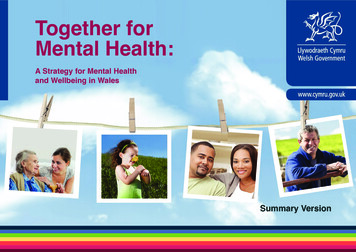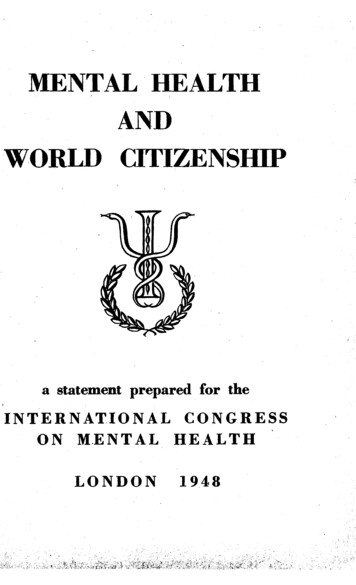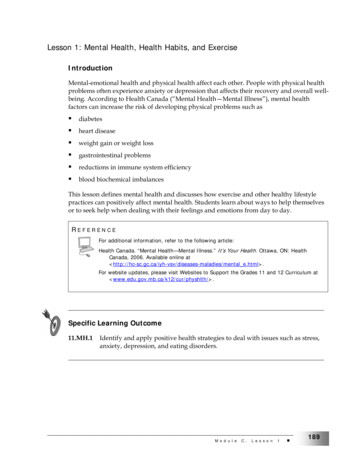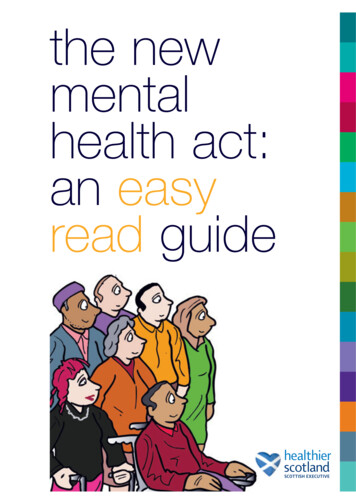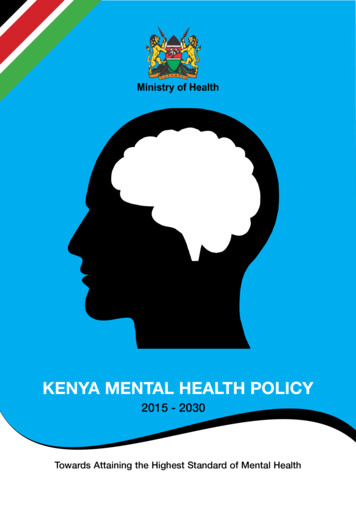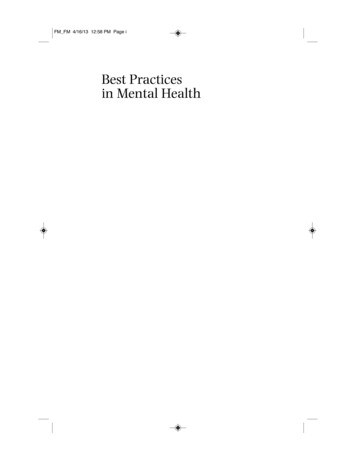
Transcription
FM FM 4/16/13 12:58 PM Page iBest Practicesin Mental Health
FM FM 4/16/13 12:58 PM Page iiBest Practices in Mental HealthEditors in ChiefVikki L. Vandiver, DrPH, MSWKevin Corcoran, PhD, JDProfessor and Associate DeanPortland State UniversitySchool of Social Work1800 SW 6th St/PO Box 751Portland, OR 97207-0751(503) 725-5007bpmh@lyceumbooks.comProfessorPortland State UniversitySchool of Social Work1800 SW 6th St/PO Box 751Portland, OR 97207-0751(503) 962-0995bpmh@lyceumbooks.comBook EditorRobert H. Keefe, PhD, ACSWEditorial AssistantsKristin BeersStephanie SundborgAssociate ProfessorSchool of Social Work685 Baldy HallUniversity at BuffaloState University of New YorkBuffalo, NY 14260-1050716/645-3381 ext. 255rhkeefe@buffalo.eduPortland State UniversityPublisherDavid C. FollmerLyceum Books, Inc.Best Practices in Mental HealthVolume 9, Number 1, March 2013 2013 by Lyceum Books, Inc. All rights reserved.Best Practices in Mental Health is published January and July by Lyceum Books, Inc.,5758 S. Blackstone Ave., Chicago, IL 60637. The subscription rate is U.S. 40.00 for individualsand U.S. 90.00 for libraries and institutions. Copies for individuals are available for U.S. 20.00.For all purchases, add U.S. 15.00 for delivery outside of the United States.Articles and advertisements in Best Practices in Mental Health do not constitute endorsement bythe editors, Portland State University, SUNY University at Buffalo, or Lyceum Books, Inc.The full text of Best Practices in Mental Health will be found on EBSCO Publishing’s academicdatabase called Academic Search Premier. The journal is also indexed in CSA/SociologicalAbstracts, Journalseek, Ulrich’s Periodicals Directory, Child Welfare Information Gateway(selected/appropriate articles), Academic Search Complete, Academic Search Premier,Academic Search Research & Development, Biography Reference Bank, Social Sciences FullText, and PsycINFO.For subscription and advertising inquiries, please contact the publisher by phone(773/643-1902) or email (lyceum@lyceumbooks.com).Printed in the United States of AmericaDate of Issue: March 2013International Standard Serial Number: 1553-555X
FM FM 4/16/13 12:58 PM Page iiiEditorial BoardAlean Al-KrenawiBruce NisbetMemorial University of NewfoundlandBuffalo State UniversityMary I. ArmstrongThomas O’HareFlorida Mental Health InstituteBoston CollegeKia J. BentleyDavid PattersonVirginia Commonwealth UniversityUniversity of TennesseeDaphne CainMaria PuigLouisiana State UniversityColorado State UniversityGrant CharlesMark RaggUniversity of British ColumbiaUniversity of Eastern MichiganMonit CheungIan F. ShawUniversity of HoustonUniversity of YorkIra C. ColbyJackie SieppertUniversity of HoustonUniversity of CalgaryLena DominelliHaluk SoydanDurham UniversityUniversity of Southern CaliforniaRichard EdwardsKaren M. StallerRutgers, The State University of New JerseyUniversity of MichiganChristopher G. HudsonMakmur SunusiSalem State UniversityMinistry of Social Affairs Republic of IndonesiaSean JoeBruce ThyerUniversity of MichiganFlorida State UniversityStuart KirkMaria Elena Ramos TovarUniversity of California, Los AngelesUniversidad Autonoma de Nuevo LeonDavid KondratJohn J. VaccaUniversity of South FloridaSaint Joseph’s UniversityWynne Sandra KorrJack C. WallUniversity of Illinois, Urbana-ChampaignLoyola University ChicagoCraig Winston LeCroyAlex WashingtonArizona State UniversityCalifornia State University, Long Beach
FM FM 4/16/13 12:58 PM Page iv
FM FM 4/16/13 12:58 PM Page vBest Practices inMental HealthVOL. 9No. 1MARCH2013viiEditorial Policy and Submission GuidelinesxiLetter from the Editors: “Evidence” for Best PracticeKevin Corcoran and Vikki L. VandiverArticles1A Systematic and Empirical Review of Mindfulness Interventionswith Adolescents: A Potential Fit for Delinquency InterventionKatherine L. Montgomery, Johnny S. Kim, David W. Springer, and Joy A. Learman20Youthful Offender Diversion Project: YODACatheleen Jordan, Peter Lehmann, Kristin Whitehill, Lieu Huynh, Kingsley Chigbu,Richard Schoech, Jamie Cummings, and Debra Bezner31The Full Spectrum: Hispanic Understanding of AutismHeather Voelkel, Craig W. LeCroy, Lela Rankin Williams, and Jane Holschuh47Promotion of Holistic Development in University Students:A Credit-Bearing Course on Leadership and IntrapersonalDevelopmentDaniel T. L. Shek62Reducing Health Disparities for People with SeriousMental Illness: Development and Feasibility of aPeer Health Navigation InterventionJohn S. Brekke, Elizabeth Siantz, Rohini Pahwa, Erin Kelly, Louise Tallen, andAnthony Fulginiti
FM FM 4/16/13 12:58 PM Page viviBest Practices in Mental HealthBrief Report83Conceptual Underpinnings of the Evidence-Based PracticeSustainability IndexTrevor J. Manthey and Rick GoschaCase Study99When Bambi Meets Godzilla: A Practitioner’s ExperienceAdapting and Implementing a Manualized Treatment in aCommunity Mental Health SettingJonathan B. Singer and Catherine M. GreenoBook Reviews117Character Formation and Identity in Adolescence:Clinical and Developmental IssuesReviewed by Jed Metzger118Citizenship Social Work with Older PeopleReviewed by Jason Dauenhauer120Advocacy Practice for Social Justice, 2nd EditionReviewed by Pamela ViggianiWebsite Review123Your Attention, Please: A Review of Selected Websites onAttention Deficit Hyperactivity DisordersKristin Beers and Stephanie Sundborg
FM FM 4/16/13 12:58 PM Page viiBest Practices inMental HealthEDITORIAL POLICYAND SUBMISSIONGUIDELINESAims and PoliciesBest Practices in Mental Health is a refereed publication intended for an interdisciplinary audience ofmental health practitioners, administrators, and scholars. The journal publishes original, practicefocused articles that are in keeping with the best possible evidence about what works in clinical, community, and/or organizational settings. Each issue includes information on innovative programs, interventions, new research efforts, book reviews, and descriptions and links to relevant websites.The journal seeks to provide readers with an array of articles on topics ranging from the microapplication of a single practice intervention, such as psychoeducation, to macro applications such asaccreditation standards. Manuscripts are solicited from the entire mental health community and alsoinvited from other educators, researchers, policy makers, and practitioners whose focus is onstrengthening the knowledge base of mental health practices.Categories of Best PracticesBest practices is a term with a broad definition that has numerous applications. The journal reviewsfour areas of mental health practices: (1) best practices, (2) emerging practices, (3) practice-basedevidence, and (4) evidence-based practice. We ask that contributors ensure submissions meet at leastone of these categories of best practices as described below.Best practices for mental health can be described as a method or technique that has consistentlyshown results superior to those achieved with other means and is often used as a benchmark for others to base their practices on. Additionally, best practices guidelines are determined through a thorough process that includes research findings, clinical experience, and implementation guidelineswhich are then debated and discussed by panels of specialists including clinicians, researchers, program administrators, and client advocates.Emerging practices are defined as treatments and services that are promising, are less thoroughlydocumented than evidence-based practices, and have a strong research foundation but fewer thanfive scientifically rigorous published studies. Emerging practices are often administrative or clinicalpractices that have proven effective at achieving a specific aim, hold promise for other organizations,and show effectiveness in small-scale projects where research designs are less rigorous or self-reporting measures are used.
FM FM 4/16/13 12:58 PM Page viiiviiiBest Practices in Mental HealthPractice-based evidence is defined as evidence of real-world data collection and focuses heavilyon improving practice. Descriptions are focused on effectiveness and practice, and studies oftendescribe routine practices that have high external validity but little inferential generalizability.Evidence-based practices are those interventions for which there is consistent scientific evidenceshowing that they improve client outcomes, with one or more replications of the original studies.Overall, best practices are broadly seen as activities, programs, and guidelines that have been created based on careful identification and synthesis of the best available evidence in a particular fieldof practice.Types of ArticlesBest Practices accepts regular articles and brief reports, both of which can include conceptual papers(e.g., descriptive best practices), research reports (e.g., empirically supported best practices), and specialty topic literature reviews (e.g., best practices for transition-age youth). Anyone interested in submitting such material should contact the editors. From time to time, the editors will solicit articles onspecial topics and will feature such special topics as consumer-selected best practices, commentaries,and field notes. Book reviews are a regular feature of the journal and are usually solicited by the editors.The following section describes the recommended format and procedures for conceptual andresearch manuscripts and book reviews.Conceptual articles. The format for conceptual articles is introduction, best practices program orintervention description, preliminary findings, discussion (e.g., including implications for best practices), and conclusion. The introduction can include literature review, issues, problem statement, andidentification of best practice category. The program or intervention description can include theoretical perspective, program description or design, components, steps for implementing best practice, orcurriculum description. Preliminary findings can reference evaluation efforts and results, and notewhether informed consent and institutional review board approval was obtained. The discussion section can describe findings, limitations of the intervention or program, recommendations for futuredevelopment, and implications for best practices. The conclusion section pulls it all together andrefers to main findings or conclusions supported by the discussion.Research reports. The standard format for research reports is introduction, methods, results, discussion (with implications for best practices), and conclusion. In the last paragraph of the introduction,state the purpose of the research as either a statement or a research question, indicate type of studydesign (e.g., experimental, survey), and identify which category of best practice this article represents.Include descriptive data of participants or population, dates for original data collection, and statementof whether informed consent or institutional review board approval was obtained. In the methods section, describe the data analysis procedures in a manner understandable to nonstatisticians. In theresults section, report findings directly related to the research purpose or question. This section canreport numbers of all percentages (in either text or table) as well as statistically significant results (e.g.,values, degrees of freedom, probability levels). The discussion section should describe limitations aswell as explicitly discuss the findings in relation to application and implications for best practices.Book reviews. The journal’s intent is to publish book reviews that are relevant to readers interestedin resources for best practices in mental health. Books to be considered for review should be sent toRobert H. Keefe, PhD, ACSW, School of Social Work, 685 Baldy Hall, University at Buffalo, State University of New York, Buffalo, NY 14260-1050, or rhkeefe@buffalo.edu. Potential reviewers shouldcontact Professor Keefe.
FM FM 4/16/13 12:58 PM Page ixEditorial Policy and Submission GuidelinesixSubmission of ManuscriptsGeneral RequirementsBest Practices reviews material for publication on condition that it has not been previously published,including electronic publication, and is not being reviewed for publication elsewhere. For peer review,all submissions must:1. Be sent electronically to bpmh@lyceumbooks.com as one file folder containing multiple documents. For example, the folder must have separate e-files for the following: cover letter; title page with author names, affiliations, and contact information; article manuscript without author names on the title page, but including an abstract, keywords, full article text, references, and acknowledgments; tables and figures (if any), submitted as separate files, with a corresponding callout in thetext.Files should be prepared using Microsoft Word and saved as .doc (not .docx) files. All tablesand figures must fit on the page with portrait (not landscape) orientation; PowerPoint figuresare not accepted. The entire article manuscript must be without author identification. E-mailor phone inquiries may be made directly to either editor: Vikki L. Vandiver, vandivv@pdx.edu,503-725-5007; or Kevin Corcoran, cikc@pdx.edu, 503-962-0995.2. Conform to the Publication Manual of the American Psychological Association, 6th edition(APA) for citations and references only; text style should follow the Chicago Manual of Style,16th edition. Please use person-first (e.g., person with schizophrenia, not schizophrenic;research participants, not subjects) and nonsexist language.3. Be double-spaced (including tables), using 12 point font (Times New Roman preferred) with 1inch margins. Do not use bold or underline. Number pages numbered in the upper right-handcorner.4. Conform to word and page limits. Regular articles should not exceed 5,000 words (abouttwenty pages). Brief reports should not exceed 800 words (about four pages). Book reviewsshould be about 600 words (about three pages).5. Identify in the cover letter all authors and their contact information, include a statement claiming that the manuscript is not under review elsewhere, and note which category the manuscript should be reviewed under (best practices, emerging practices, practice-based evidence,or evidence-based practice).Arranging the ManuscriptBest Practices uses a blind review system, thus all manuscripts must have a separate title page thatcan be removed when the manuscript is sent for review. As described above, please provide TWO titlepages, one with title of manuscript and all authors’ names, affiliations, and contact information; anda second title page in the article manuscript with NO author identification.Authors. Only principal writers should be listed as authors. Persons listed as authors must havemade substantial contributions to the article and must be able to take public responsibility for it.Other contributors may be named in the acknowledgments. For each author, list no more than twoacademic degrees or certifications and the primary current affiliation (including specific title anddepartment, agency, or university affiliation).
FM FM 4/16/13 12:58 PM Page xxBest Practices in Mental HealthAcknowledgments. Acknowledgment of individuals or groups is limited to those who contributedto the article’s intellectual or technical content. List all financial support, including grants and supportfrom foundations and/or the pharmaceutical industry. For grants, include the grant number and fullname of granting agency.Abstract and key words. The abstract is meant to be a brief, succinct summary of the manuscript,no longer than about 150 words. It is recommended that authors follow the format sectionsdescribed for conceptual or research papers (given above). Following the abstract, list key words thatcharacterize your manuscript (e.g., geriatric depression; home care; screening); please provide two orthree terms.Manuscript. Whether your manuscript is a regular article (about twenty pages or 5,000 words) ora brief report (about four pages or 800 words), please structure the sections using the guidelineslisted under conceptual or research.Tables and figures. Include tables only when they present relevant numerical data more clearlythan can be done in text; all tables should be referenced in text. Please limit tables to one or two perarticle. Figures can be used to illustrate a variety of relationships (e.g., logic models, flow charts, orprogram diagrams). These should be formatted in Microsoft Word (using SmartArt, drawing tools, ora text box), portrait orientation, no use of color, uncluttered, and clearly presented. Each table orfigure should have its own electronic file, clearly labeled. Be sure to indicate in the text approximatelywhere each table or figure should appear.References. Please use care when preparing your article references. References cause the greatestloss of time and productivity when your article is being reviewed, copy edited, and typeset. Limit references to relevant published material cited in the text. Prior to submission of your article for review,please check to see that spelling of names, titles, years of publication, up-to-date URLs, and pagenumbers are correct and consistent. Please refer to previous issues of this journal for publishing style,and consult the APA Publication Manual for any questions on how to prepare your references.Review Process and Editorial DecisionManuscripts submitted for publication are sent for blind peer review to three editorial board members. Final decision for publication rests with the editors.Timeline. The journal is published twice yearly (January and June). The peer review process takesapproximately one month, after which time the editors will communicate the editorial decision to theauthor(s) along with a summary of information about the decision and, if appropriate, recommendations for revision of the manuscript for publication or resubmission for a second review. Once finalmanuscripts are accepted and revisions (if needed) are completed, a future publication and issue datewill be provided to the author(s).Revised manuscripts. Authors may be asked whether they wish to make suggested revisions, andif so, a time frame will be given for turnaround.
FM FM 4/16/13 12:58 PM Page xiLetter from the Editors“Evidence” for Best PracticeKevin Corcoran and Vikki L. VandiverThis journal was conceived from the need to develop and disseminate informationon best practices in mental health. To a measurable degree it has succeeded. Andyet, in the decade since its conceptualization much has changed in best practices.This has resulted in considerably more published articles, books, and manualsdistinguishing what works (or seems to work based on probability) from whatseems not to work in the treatment of persons with mental health conditions.One change has been the broadening of the scope of what is meant by bestpractices: that is, the amount of available evidence balanced against its probativeor persuasive value. A broader scope seems necessary, in part, because best practice has always included evidence. The idea of using evidence in practice is notnew and has always been a part of clinical practice (Corcoran, 2007).Historically, no example is more persuasive than the Greek practice of medicine. Their approach to health care was based on observations or data, that is, evidence. Although these observations were not highly accurate (i.e., valid), theywere consistent (i.e., reliable). Key to this approach were observations of blooddrying, resulting in the theory that there are four types of bodily fluids or humors:blood, phlegm, bile, and black bile. This was consistent with the Greeks’ quadraticworld view: four seasons, four components of the environment (hot, cold, wet, anddry), four directions (north, east, south, and west), four elements in the universe(earth, wind, fire, and water), and so forth (Barry, 2004). It all made perfect senseand was based on evidence.It would be 600 years before further advancement was made, by way ofGalenic medicine (Galen, 130–200 CE), a mere tinkering with the Hippocraticnotions using a critically different method, known as active observations. Galen wasquite influential, and his procedures were considered the best practice throughoutthe Christian and Muslim worlds. Galenic medicine was evidence-based and treatments were derived from observations. With integrity, the theory of balance andimbalance in the body system (i.e., the four body humors being out of whack) produced such interventions as bloodletting, sweating, urinating, defecating, vomiting, and other methods of purging to restore the balance between blood, phlegm,
FM FM 4/16/13 12:58 PM Page xiixiiBest Practices in Mental Healthbile, and black bile. Of these methods, the best practice soon became bloodletting,whereas vomiting, urinating, and defecating fell into disfavor. If tenacity is a criterion for knowledge (Rubin and Babbie, 2010), then there is something to be saidabout Galen and best practice, as both Near Eastern and Western medicine wouldwait another 1,500 years before any noticeable advancement would occur. Andyet, perhaps this illustrates that the problem with traditions is that they get old.The defining issue of best practices, then, is not evidence per se, but the probative value of that evidence when applied to the proper question. The challenge forresearchers and practitioners of best practice is to understand how sound evidence is established and to use practices for particular problems that are based onpersuasive evidence. Over the decades the gold standard has been the randomizedcontrolled trial, and rightfully so, but not without internal and external threats tovalidity.Some best practices have had the benefit of extensive research, whereas recentinterventions for new or different mental health conditions, such as those foundat sites including the Substance Abuse and Mental Health Services Administration, Robert Wood Johnson Foundation, and Hazelden & Dartmouth PsychiatricResearch Center, have not. In contrast, work with Indian youth using culturallyappropriate interventions is quite new (see Vandiver, 2013), but the evidence,although from less rigorous procedures such as quasi-experimental designs, ispromising and suggests an emerging best practice.Vandiver (2013) delineates four ways of considering what is best practice:1. research evidence proving that a practice works (i.e., evidence-based);2. practitioners’ opinions about what works in practice (i.e., clinical consensussuch as those produced by the Institute of Medicine);3. cultural and local context that determines if and how a practice works hereand now (i.e., practice-based evidence), along with a scientific frameworkthat incorporates culturally based interventions (again, practice-basedevidence); and4. guidelines or a general plan of action that requires specification to fit theparticular circumstances in which the system of care is being implemented.All of these sources of best practice will be considered for publication in Best Practices in Mental Health.One type of evidence that the editors believe is slightly new to this journalappears in the inclusion of articles based on practice-based evidence. Althoughthe debate between evidence-based practice and practice-based evidence continues, it is clear that both are of considerable value. It can be argued even to themost rigid empirical scientist that experience matters. In all likelihood, with experience, scientists become much more proficient than they were when they enteredthe field. We improve because we observe our practices and refine our skills.
FM FM 4/16/13 12:58 PM Page xiiiLetter from the EditorsxiiiGladwell (2008) illustrates this concept in his delightful discussion of the10,000-hour rule. For various reasons it seems that 10,000 hours of practice isthe magic number of hours needed to make an expert. As all musicians, athletes,artists, and authors know, success results from practice, practice, and more practice. This hypothesis does seem to work, and in every sense of the word, experienceis “practice-based evidence.” We hope to include exceptional pieces that illustratethis, along with articles using more rigorous methodologies. After all, the goal ofBest Practices in Mental Health is to develop and disseminate what seems to work.To this end, the format of the journal has been changed. We intend to continuethe strong tradition of special issues once a year or so, and to organize the entriesto include an editorial, research articles, brief reports, book reviews, and a newsection by Kristin Beers and Stephanie Sundborg that reviews websites on a particular topic. This section will be called Website Review, and the first entry is areview of sites about attention deficit hyperactivity disorders, which seems appropriate because many of the articles in this issue concern youth and young adults.Finally, all authors will be asked to conclude with a section specifically addressingthe implications for best practice, with the intent of providing directions for practitioners. We welcome manuscripts of all types, and hope you find the new formatsatisfactory.ReferencesBarry, J. M. (2004). The great influenza: The epic story of the deadliest plague in history. New York: Viking.Corcoran, K. (2007). From the scientific revolution to evidence-based practice:Teaching the long journey of a short past. Research on Social Work Practice, 17(5), 548–552.Gladwell, M. (2008). Outliers: The story of success. New York: Back Bay Books.Rubin, A., & Babbie, E. (2010). Research methods for social work. Belmont, CA:Brooks Cole/Cengage.Vandiver, V. L. (2013). Best practices in community mental health. Chicago: LyceumBooks.
FM FM 4/16/13 12:58 PM Page xiv
Chapter 01 Chapter 01 4/16/13 11:02 AM Page 1A Systematic and Empirical Review ofMindfulness Interventions with Adolescents:A Potential Fit for Delinquency InterventionKatherine L. Montgomery, Johnny S. Kim, David W. Springer, andJoy A. LearmanMindfulness therapies have gained considerable attention recently in empirical literature, revealing promise for the reduction of a variety of psychological and physiologicalsymptoms among adults. Studies have offered promising results regarding the efficacyof Acceptance and Commitment Therapy (ACT), Dialectical Behavior Therapy (DBT),Mindfulness-Based Cognitive Therapy (MBCT), and Mindfulness-Based Stress Reduction (MBSR) for use with problems such as depression, anxiety disorders, borderlinepersonality traits, internalizing and externalizing problems, chronic pain, psychosis,and epilepsy. Only in recent years have researchers begun to investigate the impact ofmindfulness therapies on adolescent illnesses. To date, however, there has been no synthesis of research on mindfulness therapies with adolescents. Using specific inclusionand exclusion criteria, a systematic synthesis of the literature yielded a final sample offifteen studies (two ACT, twelve DBT, and one MBSR). When they were not reported inthe studies, effect sizes (Hedges’s g) were calculated for all outcome measures usingComprehensive Meta-Analysis 2.0 software. The majority of included studies reflectedmoderate to very large effect sizes regarding the impact of the mindfulness therapies onoutcome variables; however, only particular variables were significant. Findings fromthis systematic review offer a first step toward understanding the impact of mindfulness therapies with adolescents.Key words: Acceptance and Commitment Therapy; Dialectical Behavior Therapy;Mindfulness-Based Cognitive Therapy; Mindfulness-Based Stress Reduction Therapy; systematic review“It is our own thoughts, inaccurate beliefs, unrealistic expectations, and insatiabledesires that obscure and distort our direct perceptions. Thinking is actually theKatherine L. Montgomery, MSSW, PhD, holds a post doctorate at George Warren Brown School ofSocial Work, Washington University, St. Louis, Missouri. Johnny S. Kim, PhD, is associate professor at the University of Kansas. David W. Springer, PhD, is professor at University of Texas atAustin. Joy A. Learman, MSW, is a PhD candidate at the University of Texas at Austin. 2013 Lyceum Books, Inc., Best Practices in Mental Health, Vol. 9, No. 1, March 2013
Chapter 01 Chapter 01 4/16/13 11:02 AM Page 22Best Practices in Mental Healthproblem, not (as we often assume) the solution” (Semple & Lee, 2008, p. 64). Thisquote highlights the primary difference between the traditional cognitive behavioral therapies (CBTs) and mindfulness therapies. Although both assert that thinking contributes to the problem, traditional cognitive-behavioral therapists putsubstantial emphasis on altering thinking as a means to change behavior (Craske,2009). Alternatively, the mindfulness therapies seek to alter individuals’ contextand relationship with their thinking rather than the actual thoughts (Greco &Hayes, 2008).Mindfulness, or third-wave, behavioral therapies are relatively new and havegained popularity in research literature during the last two decades (Keng,Smoski, & Robins, 2011). These therapies have revealed particular promise for thereduction of a variety of psychological and physiological symptoms among adults(Keng et al., 2011; Montgomery, Kim, & Franklin, 2011). Specifically, studieshave offered promising results regarding the efficacy of Acceptance and Commitment Therapy (ACT), Dialectical Behavior Therapy (DBT), Mindfulness-Based Cognitive Therapy (MBCT), and Mindfulness-Based Stress Reduction (MBSR) withissues such as depression (Grossman, Niemann, Schmidt, & Walach, 2004; Ma &Teasdale, 2004; Teasdale et al., 2000; Vowles & McCracken, 2008), anxiety disorders (Dalrymple & Herbert, 2007; Grossman et al., 2004), borderline personality traits (Dimeff & Koerner, 2007), chronic pain (Dahl, Wilson, & Nilsson, 2004;Wicksell, Melin, Lekander, & Olsson, 2009), eating disorders (Wi
Vikki L. Vandiver, DrPH, MSW Kevin Corcoran, PhD, JD Professor and Associate Dean Professor Portland State University Portland State University School of Social Work School of Social Work 1800 SW 6th St/PO Box 751 1800 SW 6th St/PO Box 751 Portland, OR 97207-0751 Portland, OR 97207-0751 (503) 725-5007 (503) 962-0995

